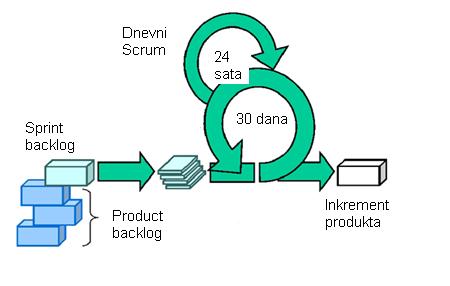Scrum is a process framework that is used to manage complex development. Scrum is not a methodology or technique of software development, but a framework within which various processes and techniques can be used (e.g., Extreme Programming). As already mentioned Scrum framework consists of Scrum teams, their associated roles, events, artifacts and rules.

Scrum team consists of a Product Owner, Development team and Scrum Master. Scrum delivers products iteratively and incrementally, maximizing possible informational feedback.
Product Owner is responsible for maximizing value of the product and the work of the development team. Way in which this is achieved is very different between the various organizations, teams and people. The owner of the product is solely responsible for managing Product Backlog which includes clear description of vision, objectives and items in the Product Backlog to the development team. The development team is instructed by the owner and thus the entire organization must respect his decisions.
The development team consists of experienced professionals who work an actual job of delivering product increment at the end of each sprint. Only members of the development team create product increment.
The Scrum Master is responsible of understanding and usage of Scrum. Scrum Masters achieves that in a way that they ensure the Scrum teams follow to the theory, practice, and rules of Scrum.
Scrum uses prescribed events in order to establish correctness and minimizing the need for meetings that are not defined in Scrum. Scrum uses time-limited events in a way that every event has a certain maximum duration. In this way it is ensured that sufficient time is used for planning without waste of time.
Sprint is a heart of Scrum, time-limited period of one month or less during which produces “finished”, usable and potentially deliverable product increment. Sprints are equal length throughout the entire product development process. New Sprint begins immediately after the previous. Sprint is consisted of the Sprint planning meeting, daily Scrum, business of development, Sprint revision and Sprint retrospectives. Each Sprint can be viewed as a project whose horizon does not exceed one month. Sprint is used as projects to do some work. Each Sprint has a definition of what will be done, how and who will determine the design, work and the final product.
Daily Scrum is a 15-minute, time-limited event, which is intended to harmonize the activities for the development team and make a plan for the next 24 hours. This is done by the control of the previous daily Scrum meeting and assessment of work that could be done before the next meeting. Daily Scrum is held in the same place every day in order to reduce complexity. Scrum Master is forcing the rule that only the development team participates in the daily Scrum meeting, and the meeting lasts 15 minutes.
Product backlog is sorted list of everything that may be necessary for the product and the sole source of request for any changes that are made to the product. Product Owner is responsible for product backlog, including its contents, availability, and sorting. Product backlog is never final. Initially it contains only those requirements that are initially known and understandable. Product Backlog evolves as the product evolves and the environment in which it will be applied. Product backlog contains a list of all the features, functionality, demands, repairs and upgrades, which together make the changes that will be applied over the product in the future. It is usually sorted by value, risk, priority and urgency. Backlog items at the top are part of the current development activities.
Sprint backlog is a set of items from the Product Backlog selected for the Sprint Plus plan increment realization and realization of the Sprint objective. Sprint Backlog is the assessment of the development team of which functionalities will be in the next increment and the work that is necessary for the realization of the increment.
Sprint backlog is the plan with sufficient detail for the current changes to be understood on the Daily Scrum. The development team changes the Sprint backlog during the Sprint and the tasks during the sprint are added to it. These tasks occur when the development team, working according to plan, learns more about the work that is required to meet the Sprint goal. As the need arises for a new job, the development team adds it to the Sprint backlog. Only developers can change the Sprint Backlog during the Sprint. Sprint backlog is the visible image of the work in real time which the development team intends to carry out during the sprint and which belongs exclusively to the development team.
© 2025. INFO NOVITAS - Design & Development

